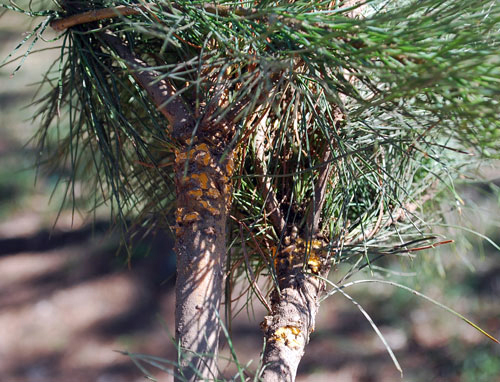White pine blister rust damage showing up
White pine blister rust cankers can kill branches or if they are found on the trunk they can girdle and eventually kill the tree.
White pine blister rust, caused by the fungus Cronartium ribicola, occurs on both eastern white pine (Pinus strobus) and currants or gooseberries (Ribes spp.). This fungus causes cankers that kill branches, or if they are on the trunk, they can girdle and eventually kill the tree. White pine blister rust needs both pine and an alternate host (gooseberry or currant) to complete its life cycle. The spores released in the spring infect only Ribes (gooseberry and currant) allowing the fungus to continue its life cycle. The rust fungus on Ribes will produce another spore that then will infect white pine in mid-summer to early fall. In the spring on white pine you will find cream-colored blisters pushing through the bark.

Powdery, yellow-orange spores cover the surface of the canker on young white pine trees.
You may also see the blisters open and the orange-yellow spores visible. These spores can be carried in the wind over long distances to the alternative host.
There are no fungicides available for prevention or treatment of white pine blister rust. Cultural control methods should include:
- Pruning out infected branches and twigs as soon as they are noticed. The majority of infections occur on pines within a few feet of the ground.
- Eliminating Ribes at a minimum of 1,000 feet of the white pine plantation to reduce the amount of infection as spores from white pine cannot re-infect white pine.
For more information, see Integrated Pest Management for Christmas Tree Production (Pennsylvania State), page 99.



 Print
Print Email
Email

